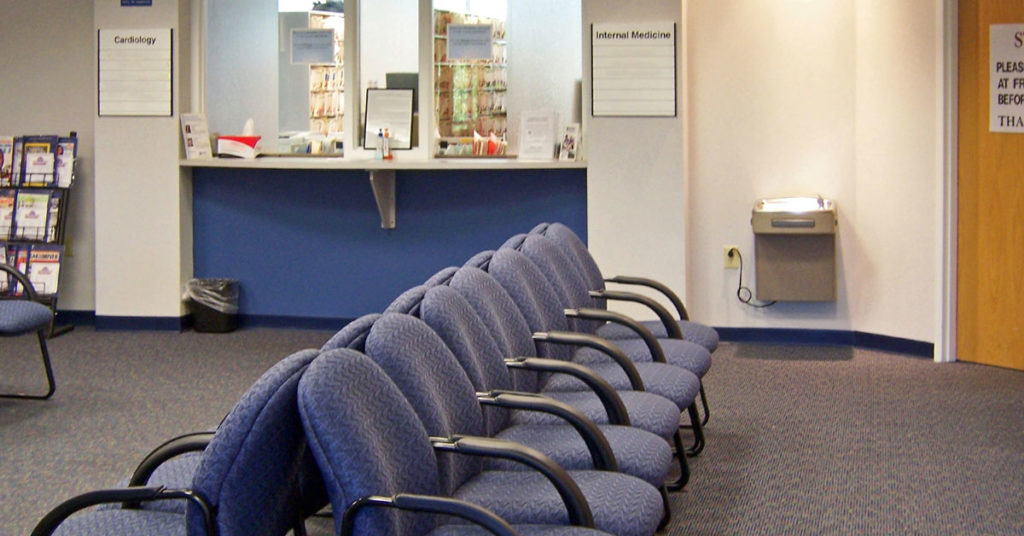Poor patient satisfaction scores can hurt an organization’s reputation and bottom line. As patients are becoming more savvy healthcare consumers, providing and maintaining an exceptional patient experience is not only a key to success, it is necessary for survival. Avoid these seven deadly sins when implementing a strategy for improving the patient experience:
 1. Lack of Empathy
1. Lack of Empathy
Empathy : “The feeling that you understand and share another person’s experiences and emotions.” (1)
“Empathy has strong correlation with patient satisfaction.” (2)
Responding to the emotional needs of patients with empathy and compassion can be challenging and it takes much practice to get it right. The first step is to recognize that there is an emotional need, and then act accordingly based on each patient’s unique circumstance.
Without empathy, at best the patient experience feels robotic and at worse, you lose a customer.
 2. Nonverbal Language
2. Nonverbal Language
Little or no eye contact, a posture of crossed arms, or staying fixated on your computer screen are nonverbal ways of communicating with the patient that expresses negative body language. Sometimes we express negative body language without being aware that we are sending the wrong message. Most of us can do a better job of being mindful of our body language, making an asserted effort to display positive body language.
 3. Access Challenges
3. Access Challenges
Lack of access, especially acute access, is one of the major challenges facing physician practices across the country. One huge advantage your practice has today is the deployment of a patient portal. While not all patient portals are created equally (some are more patient-friendly than others) almost every patient portal will allow the basics; a) the convenience of going online to schedule an appointment, b) request Rx refills, c) review test results or medical records, and d) pay outstanding account balances. Providing Acute Access appointments is a key success factor in building patient loyalty and retaining patients.
 4. Disregard for Timeliness
4. Disregard for Timeliness
Nearly 100% of all physician practices will experience an off-schedule situation from time to time. Keeping average wait times to 15 minutes or less is a good goal. As a matter of fact, the CAHPS questionnaire measures wait time using the following question.
“Wait Time includes time spent in the waiting room and exam room. During this visit, did you see this provider within 15 minutes of your appointment time?”
- Yes
- No
Using MedicalGPS’ patient feedback tool, M3-Patient Experience®, the MedicalGPS national database shows the percentage of patients answering “Yes” to the above wait time question is right at 85%.
One good technique to soften the impact of an off-schedule operation is to perform “Waiting Room Rounding”. To learn more about Waiting Room Rounding, read Patient Courtesy and Waiting Room Rounding Fosters Five-Star Customer Service.
 5. Poor Communication
5. Poor Communication
Trying to get a word in edgewise is defined as; “To speak or express one’s opinion despite other people dominating the conversation (hence the image of squeezing words in “edgewise”—sideways). Usually used in negative constructions to convey the opposite.” (3)
During a typical patient office visit, interaction with the care team involves the transfer of much information to the patient. Sometimes the communication channel is mostly one-way, meaning the care team spends a lot of time explaining the diagnosis, prognosis, and otherwise transferring their professional knowledge to the patient. Effective communication involves two-way communication. Utilizing active listening techniques helps the patient feel at ease and more willing to share their feelings, thoughts, opinions, and behaviors. Patients desire to comprehend; however, patients also want to know that they are being understood and heard. Effective communication involves a heavy dose of active listening.
 6. Operational Inefficiency
6. Operational Inefficiency
Everybody hates wasting time. Physician practices that still operate with inefficiencies and duplication will find their patients leaving for alternative sources to meet their healthcare needs.
For example, one physician’s office that I visited not too long ago had me fill out the same health status form (paper form I might add) that I had filled out on my previous visit. The health status questionnaire was quite long and seemed to take forever to complete. While this provider, a dermatologist, is not my primary care provider, I do see this dermatologist annually.
On a more positive note, as part of my most recent visit to my primary care provider, as soon as the appointment was booked, I received an email, inviting me to fill out the pre-visit information using my phone or computer. The online form was lengthy for sure, however, because I had previously answered many of the questions before, my electronic health information was tied to the online form and many of the questions were pre-populated, only requiring that I make updates as needed.
In today’s world, almost all of us have a lot of experience online. Having the opportunity to complete the required “paperwork” prior to a doctor visit is expected. Providing patients with an online option is essential.
 7. Apathy
7. Apathy
“Lack of feeling or emotion, lack of interest or concern”, pretty much sums up apathy. (4)
As I walked towards the check-in counter at my primary care doctor’s office, the receptionist looks up from the screen, offers me a warm smile and says, “Good afternoon, my name is Brenda.” I said, “Hello, I am Jerry Stone.” Brenda replied, “I thought you were Mr. Stone, I see you have a 3:30 appointment with Dr. Green (doctor name changed for this publication). Now that’s impressive. I was about 15 minutes early, even so, the receptionist had deducted, based on the information she had available (my appointment time, age, gender, and other information), that I was most likely Jerry Stone arriving for my 3:30 PM appointment. The receptionist timed the greeting perfectly, as well. She smiled while I was about 10 or 15 feet away from the check-in counter but waited until I was right up to the check-in counter, surrounded by the privacy of the check-in partitions, before asking for my name.
Brenda made me feel special and showed interest in me, meaning Brenda had taken some time to get familiar with me and knew the doctor that I was there to see. Any apathy there? None. Only caring and concern.

Please let us know if you have comments or questions, and subscribe to our Email Updates so that you can be assured to receive Thinking Thursdays TIPs.
Thank you!
Jerry
Jerry L. Stone
Co-Founder/COO
MedicalGPS, LLC
RESOURCES


2 thoughts on “Avoiding the 7 Deadly Sins of Patient Experience”